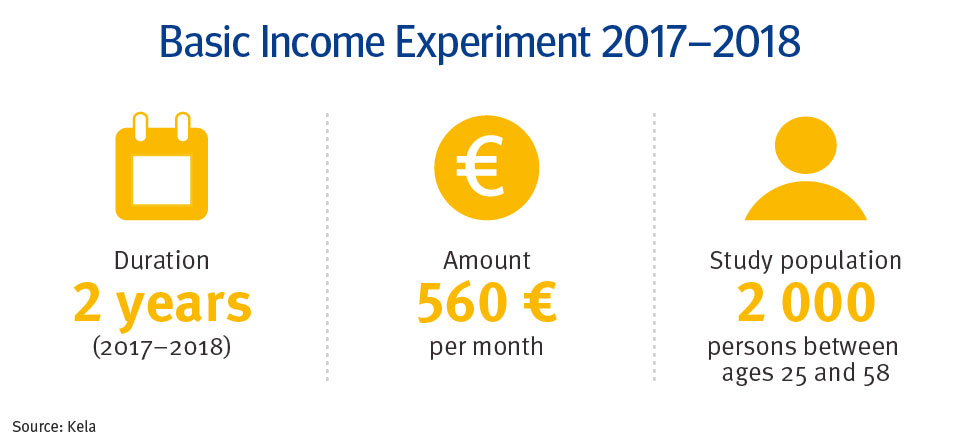Basic income experiment at halfway point
Analysis of effects will begin after the experiment concludes at the end of 2018.
An experiment testing a basic income was launched in Finland in January 2017. Scheduled to run until the end of 2018, the experiment is about to reach the halfway point.
It is proceeding according to plan, with the 2,000 participants receiving a €560 monthly basic income payment, which is independent of any other income they may have and not conditional on undertaking an active search for employment.

Analysis of effects not possible until the experiment has ended
The purpose of the experiment is to study the effect that simplifying the social security system and increasing cash incentives for work has on the employment rate of the study participants.
This will be analysed after the experiment has ended. The analysis will be made on the basis of data collected in administrative registries, and therefore, it will not be necessary to contact the participants personally or to interview them.
However, there is a one-year time delay before the registry data are released, which means that an analysis of the first-year impact will not be possible until the experiment has ended. Similarly, employment effects across the whole experiment cannot be reported before the end of 2019.
Does the analysis extend beyond employment effects?
In a statement commenting on the experiment, the Parliamentary Committee for Social Affairs and Health announced that also other effects of the experiment, such as the participants’ perceived well-being, would be examined.
However, in order to measure the effect on well-being, it would be necessary to collect data directly from the participants, for example by means of questionnaires or interviews. Timing the data collection requires detailed planning and an evaluation of the factors to be measured as well as an assessment of the potential impact of the various stages of the experiment, such as its conclusion, on the measurements.
No results will be published while the experiment continues
As of yet, there are no findings about the effects of the basic income. The effects will not be evaluated while the experiment is in progress, because a public discussion of the results could influence the behaviour of the participants and of the control group.
Furthermore, it would not be useful to base conclusions about the long-run effects of the experiment – the point in which the Finnish Government is primarily interested – on the effects seen in the early stages.
The Finnish experiment draws international interest
The Finnish experiment testing a basic income has sparked enormous interest around the world. Kela and other Finnish authorities are contacted daily by foreign media, civic organisations, government agencies and researchers, among others.
While the tight parameters of the experiment have been criticised, it is also seen as a bold and ambitious way to seek solutions for modern social problems.
There is ongoing research at Kela looking at the amount of media attention the experiment has attracted and the topics on which it focuses.
What type of information can the experiment offer?
The basic income experiment is significantly less ambitious than envisioned by the working group which conducted the preliminary study. This was expected given how quickly the experiment was planned and its relatively small budget. Yet the experiment can provide important lessons on the difficulties of planning an ambitious social experiment and defining a realistic basic income model. After the experiment has ended, Kela will publish reports discussing these lessons.
A detailed analysis of the effects of more generous welfare provisions and more effective monetary incentives for work would require a larger sample and more diversity in the design of the study than the current experiment allows. Such a more ambitious experiment would encompass also other population groups besides the unemployed and comprise several test groups with varying basic income levels and tax rates.
There are currently no plans to continue or expand the basic income experiment after 2018. However, the Finnish Government is planning other policy experiments, such as a project exploring participatory social security, which will start at the beginning of 2018.
Optimally, the basic income experiment will shed light on how a simplified system of social provision and stronger monetary incentives for work affect the supply of labour within a specific population segment. However, the limitations of the study design should be recognised if and when the findings are introduced into the public debate on the basic income or used as background to possible future trials and decision-making aimed at reforming the social security system.
What is the basic income experiment about? Watch a video!
Olli Kangas
Professor, Director of Government and Community Relations, Kela (Social Insurance Institution of Finland)
Miska Simanainen
Researcher, Kela (Social Insurance Institution of Finland)
firstname.lastname@kela.fi
More information:
Basic Income Experiment 2017–2018(Opens in a new tab)
Basic Income Experiment: Preliminary study(Opens in a new tab)